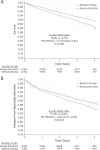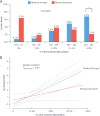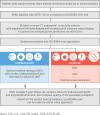Medical Therapy With Versus Without Revascularization in Stable Patients With Moderate and Severe Ischemia: The Case for Community Equipoise
- PMID: 26616030
- PMCID: PMC5545795
- DOI: 10.1016/j.jacc.2015.09.056
Medical Therapy With Versus Without Revascularization in Stable Patients With Moderate and Severe Ischemia: The Case for Community Equipoise
Abstract
All patients with stable ischemic heart disease (SIHD) should be managed with guideline-directed medical therapy (GDMT), which reduces progression of atherosclerosis and prevents coronary thrombosis. Revascularization is also indicated in patients with SIHD and progressive or refractory symptoms, despite medical management. Whether a strategy of routine revascularization (with percutaneous coronary intervention or coronary artery bypass graft surgery as appropriate) plus GDMT reduces rates of death or myocardial infarction, or improves quality of life compared to an initial approach of GDMT alone in patients with substantial ischemia is uncertain. Opinions run strongly on both sides, and evidence may be used to support either approach. Careful review of the data demonstrates the limitations of our current knowledge, resulting in a state of community equipoise. The ongoing ISCHEMIA trial (International Study of Comparative Health Effectiveness With Medical and Invasive Approaches) is being performed to determine the optimal approach to managing patients with SIHD, moderate-to-severe ischemia, and symptoms that can be controlled medically. (International Study of Comparative Health Effectiveness With Medical and Invasive Approaches [ISCHEMIA]; NCT01471522).
Keywords: angina pectoris; coronary artery bypass; coronary artery disease; guideline-directed medical therapy; percutaneous coronary intervention.
Copyright © 2016 American College of Cardiology Foundation. Published by Elsevier Inc. All rights reserved.
Figures










References
-
- Smith SC, Jr, Benjamin EJ, Bonow RO, et al. AHA/ACCF secondary prevention and risk reduction therapy for patients with coronary and other atherosclerotic vascular disease: 2011 update: a guideline from the American Heart Association and American College of Cardiology Foundation. J Am Coll Cardiol. 2011;58:2432–46. - PubMed
-
- Piepoli MF, Corrà U, Benzer W, et al. Secondary prevention through cardiac rehabilitation: from knowledge to implementation: a position paper from the Cardiac Rehabilitation Section of the European Association of Cardiovascular Prevention and Rehabilitation. Eur J Cardiovasc Prev Rehabil. 2010;17:1–17. - PubMed
-
- Keeley EC, Boura JA, Grines CL. Primary angioplasty versus intravenous thrombolytic therapy for acute myocardial infarction: a quantitative review of 23 randomised trials. Lancet. 2003;361:13–20. - PubMed
-
- Mehta SR, Cannon CP, Fox KA, et al. Routine vs selective invasive strategies in patients with acute coronary syndromes: a collaborative meta-analysis of randomized trials. JAMA. 2005;293:2908–17. - PubMed
-
- Fox KA, Clayton TC, Damman P, et al. Long-term outcome of a routine versus selective invasive strategy in patients with non-ST-segment elevation acute coronary syndrome a meta-analysis of individual patient data. J Am Coll Cardiol. 2010;55:2435–45. - PubMed
Publication types
MeSH terms
Substances
Associated data
Grants and funding
LinkOut - more resources
Full Text Sources
Other Literature Sources
Medical

